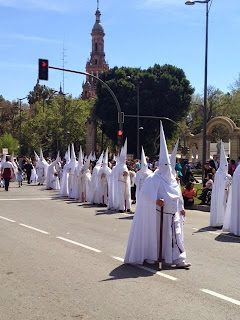We had looked forward to being in Seville for Holy Week having heard about the extraordinary celebration there. We just were in no way prepared for the extent of this celebration. The hotel advised us that we could not drive to our hotel in the old city so we left our rental at the train station (and later continued the last leg of our trip by train to Madrid!) Most all of the whole city which was already difficult to access was essentially closed to all but foot traffic for Holy Week.
The celebration consists of daily religious processions which are organized by various brotherhoods, most of whom have existed for centuries. Starting on Saturday before Palm Sunday up to 9 or 10 of these processions continue each day ending on Easter Sunday. There are a few small groups (about 200) but most of the processions are about 1000 to 1400 members processing. they move slowly and it take hours to go slowly through the narrow streets. Altogether there are about 70 different brotherhoods. The processions which begin early afternoon can last 12=14 hours ending in the early morning hours. Typically the procession begins at the home church, processes to the Cathedral for a blessings and then return to the home church.
Each procession has 2 and some times 3 pasos===El Cristo and La Virgen. These pasos weigh about 2 metric tons and are carried by teams of 20-30 men underneath. We had been told where to go where it was not too crowded. This was great because we could actually see what happened when the paseo stopped and the carriers could take a break. Also at intervals they were met by substitutes.
Each paso is usually accompanied by a band. The drums and the music actually set the pace for the paseo to move through the city.
Each paso is different , richly carved and decorated. Starting late afternoon and continuing well past our bedtime we found ourselves fascinated by this tradition.
The robed and hooded processors are anonymous penitents, nazarenos who have observed this practice for centuriess.



No comments:
Post a Comment